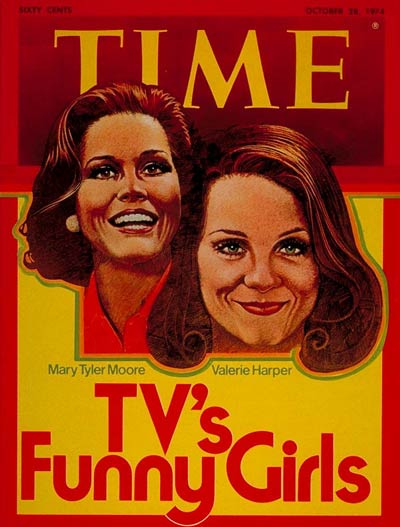
It can be hard to separate Mary Tyler Moore, the groundbreaking comic actor who has died at 80, from Mary Richards, the character she played on The Mary Tyler Moore Show. When she and erstwhile coworker Valerie Harper (whose MTM character had gotten a spin-off) were profiled in a TIME cover story in 1974, the magazine took a look at the “large gap between the show girl and the real one.”
But both versions of Mary, real and fictional, had backstory. Mary Richards was newly single, and the big-city move that got the show’s plot going represented trading housewife hopes for something new and different. Meanwhile, Moore’s career included work that came before her eponymous sitcom—and, to understand why that role was historically important, and not merely great television, those earlier roles are key.
Launching her TV career right out of high school, Moore went from playing an elf in commercials for household appliances to playing a secretary on a detective show on which the gimmick was that her hands and legs were seen on screen, but not her face. It was when she eventually landed a starring role on The Dick Van Dyke Show that fame really arrived. In one of her first appearances in the pages of TIME, a few years later, she was praised as TV’s “favorite average housewife” for her role as Laura Petrie. The write-up, in retrospect, is revealing:
Pert and brunette, Mary sends a grin across her face in waves, and her 120 lbs. are settled into a luscious 36-24-36 configuration that has male viewers sitting upright in their reclining chairs. Yet hardly a real-life wife objects. Instead, they take notes. And when she began delighting TV Hubby Dick Van Dyke by wearing Capri slacks, it helped make Capri slacks the biggest trend in U.S. casual attire.
…Of course, 27-year-old Mary is more than just a looker. She is toothily, totally wholesome, with an unexpected comedy accent on the ho, can convincingly range from point-winning wit to pratfalling clown.
When The Dick Van Dyke Show premiered, even though the calendar read 1961, the period that today might be thought of as “the ’60s” had not yet begun. The Feminine Mystique was still two years away. Though Moore’s housewife may have worn (Capri) pants, she was essentially a reflection of a pre-women’s-lib world.
The Dick Van Dyke Show ended in 1966. By the time the actor walked into the office at the fictional WJM-TV on The Mary Tyler Moore Show in 1970, the world had changed. Her new character, Mary Richards, was a happy, single career woman.
Laura Petrie and Mary Richards were both beloved television characters, but it was in the gap between them — a period of about four years in the late ’60s during which Moore was, ironically, much less visible to fans, as she took a role in a Broadway flop and struggled with personal health problems — that Mary Tyler Moore captured history changing.
The Mary Tyler Moore Show launched to decidedly mixed reviews (the story, set behind the scenes at a Minneapolis TV station, was “an injustice to even the worst of local TV news,” TIME noted) but, thanks in large part to Moore’s gifts, it quickly became one of critics’ and viewers’ favorite shows on the air. The show’s portrayal of women was a big part of that success. Mary worked, she had a romantic life, she was happy and attractive in her 30s and, perhaps most importantly of all, she was good.
“On every show [Moore and Harper] prove that women need not be dingbats or contralto foghorns to win applause or affection,” TIME noted in the 1974 cover story.
Read the full cover story here in the TIME Vault
By the time The Mary Tyler Moore Show went off the air in 1977, Mary Richards had become what Lance Morrow called a “a humanely plausible version” of what it was like to be an American woman in the 1970s.
And Mary Tyler Moore and Mary Richards did share at least one more thing in common besides their names — and it’s something that suggests Moore was happy with the changing world she helped epitomize.
“I am a career girl. I couldn’t be happy living Laura’s life,” she told TIME in 1965, of her Dick Van Dyke Show role, years before her own show began. “If I wasn’t an actress, I’d have to be doing something else — I’d go to school or I’d be a nurse, but I’d do something.”
More Must-Reads from TIME
- Donald Trump Is TIME's 2024 Person of the Year
- Why We Chose Trump as Person of the Year
- Is Intermittent Fasting Good or Bad for You?
- The 100 Must-Read Books of 2024
- The 20 Best Christmas TV Episodes
- Column: If Optimism Feels Ridiculous Now, Try Hope
- The Future of Climate Action Is Trade Policy
- Merle Bombardieri Is Helping People Make the Baby Decision
Write to Lily Rothman at lily.rothman@time.com